
 Ginesa Mª García – Rostán Pérez, MD, PhD
Ginesa Mª García – Rostán Pérez, MD, PhD
Senior Research Scientist – Group Leader – Molecular Pathologist - Associate Professor of Pathology. School of Medicine Valladolid University.
GGR's major research interest stands in the area of molecular genetics of cancer. She is internationally best known for his research in the area of molecular genetics of aggressive thyroid carcinomas
Molecular Genetics of Disease Unit
UnitLaboratory B4 – Pathobiology of Cancer: Inter-, intra-tumoral Heterogeneity and Molecular Targets
C/ Sanz y Fores s/n
47003 – Valladolid - Spain
Phone Office: +34 983186495
Laboratory Phone: 983-186437
Group Members:
-
- Joaquín Fra Rodríguez [Oncologist -Rio Hortega Hospital - Valladolid]
-
- María Álvarez – Quiñonez Sanz [Pathologist - Hospital Clínico Universitario – Valladolid]
-
- Elena Pérez Martín [PhD student - Pathologist]
-
- Sara Gil Bernabé [PhD student]
-
- Noa Feás Rodríguez [PhD student – Spanish Association for Cancer Research (AECC)]
Temporal Group Members:
-
- Miriam Corraliza Gómez [Master student September 2015-October 2016]
-
- Ignacio Ródriguez Pastrana [Summer Laboratory Practices - 2017]
-
- María Angeles Rodríguez García [Master student - September 2017 - August 2018]
-
- Paloma Pérez López [Medical student - AECC 2016 summer fellowship]
-
- José Javier Estebanez García [Medical Student AECC 2018 summer Fellowship and Undergraduate Research Internship in Biomedical Sciences 2019-2021]
-
- Miriam Mayal Etreros [Medical Student Undergraduate Research Internship in Biomedical Sciences 2019-2021]
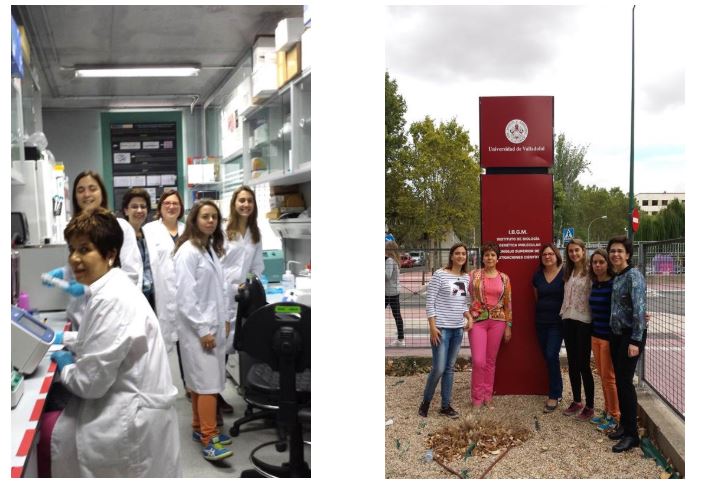
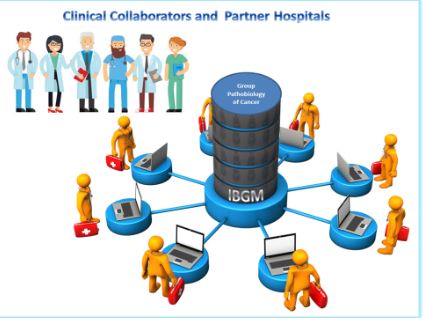
Clinical Collaborators:José Camaselle Teijeiro [Phatologist - School of Medicine - Santiago de Compostela University], Dario Morais Pérez [Otorrinolaryngologist - Hospital Clínico Universitario de Valladolid], Rosa García Centeno [Technician - Department of Pathology - Hospital Cliníco Universitario de Valladolid.
Partner Hospitals: Hospital Cliníco Universitario de Valladolid, Hospital Río Hortega de Valladolid, Hospital Clínico Salamanca, Hospital Río Carrión Palencia, Complejo Asistencial de León, Complejo Hospitalario de Avila, Complejo Hospitalario de Navarrra -Pamplona, Hospital Clínico Universitario de Santiago de Compostela, Hospital Central de Asturias - Oviedo, Hospital San Agustín de Avilés, Hospital Ramón y Cajal - Madrid, Hospital Vall d´Hebrón - Barcelona, Hospital Germans Trias I Pujol - Badalona, Hospital Vigen del Rocio - Sevilla, Hospital Virgen de la Macarena - Sevilla
Collaborations with International Research Groups [papers, research projects, PhD co-supervision -exchange of students]:
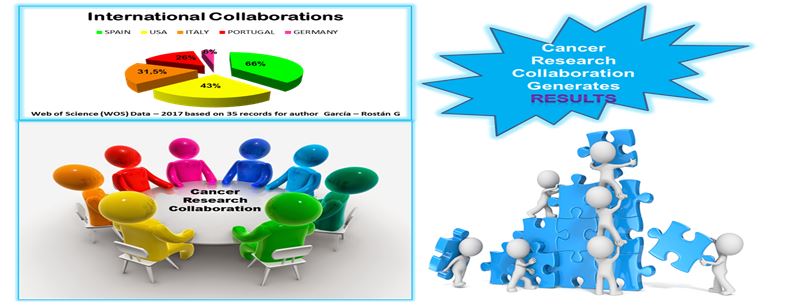
-
- Massimo Santoro Group- ITALYDipartimento di Medicina Molecolare e Bitecnologie Mediche (DMMBM). Universita Federico II, Napoli, Italy.
-
- Giuliana Salvatore Group – ITALYDipartimento di Studi delle Istituzioni e dei Sistemi Territoriali. Universita degli Studi Parthenope,” Napoli, Italy.
-
- David Rimm Group- USADepartment of Pathology – Brady Memorial Laboratory – BML 55. Yale University. New Haven. Connecticut. USA
-
- Kathleen Kelly Group – USACell and Cancer Biology Branch, Center for Cancer Research, National Cancer Institute (NCI), National Institute of Health, Bethesda, Maryland, USA.
- Manuel Sobrinho – Simoes – PORTUGALDirector do Instituto da Patología e Imunologia Molecular da Universidade do Porto (IPATIMUP). Oporto, Portugal
Group Traits and Thoughts:
We are an ambitious, interdisciplinary, highly motivated young research group that officially started at IBGM in January 2015.
We pursue developing an integrated research at the interface between cancer genetics / genomics, cellular biology, molecular pathology and clinical management of cancer patients.
As the name of the group reveals, the main scientific query that drives our research is how molecular alterations are passed along the different components of a tumor and how that influences on heterogeneity and plasticity of tumor cells. We want to comprehend how mutations arise in cancer cells and how they segregate in cancer cell subpopulations through space and time.
Tumor heterogeneity is a pivotal condition in our understanding of tumor development and evolution. The analysis of individual cancer genomes has shown not only a puzzling inter-tumor heterogeneity, with limited somatic alterations shared between identical tumor histotypes, but also a complicated intra-tumor heterogeneity, affecting individual tumor areas within a particular tumor biopsy and biopsies of the same tumor separated in space and time. Sequential analysis of tumors during disease course (primary tumor, recurrences and metastases during follow-up) has unveiled that intra-tumoral heterogeneity also evolves during disease course.
Tumor cells devise strategies to bypass the effect of small molecule cancer drugs. The selective pressure induced by targeted therapies directed against tumor cells bearing a particular mutation can result in the dominance of a minoritary sub-clon present in the tumor, which harbours molecular alterations resistant to the given drug or in the acquisition of additional driver mutations or molecular aberrations in the targeted clone or in new tumor subclones refractory to the inhibitor, that in either case raise the activity of alternate signaling pathways that rescue tumor growth and metastasis. It is important to trace the geography of clonal diversity or the subclonal architecture through treatment. To deliver curative therapies to cancer patients, will be essential to develop therapeutic algorithms that estimate inter-, and intra-tumoural heterogeneity and plasticity of cancer cells during tumor progression, influenced by the effects of treatments.
Intra-tumoral heterogeneity is often a confounder in tumor evaluation for diagnosis and treatment.
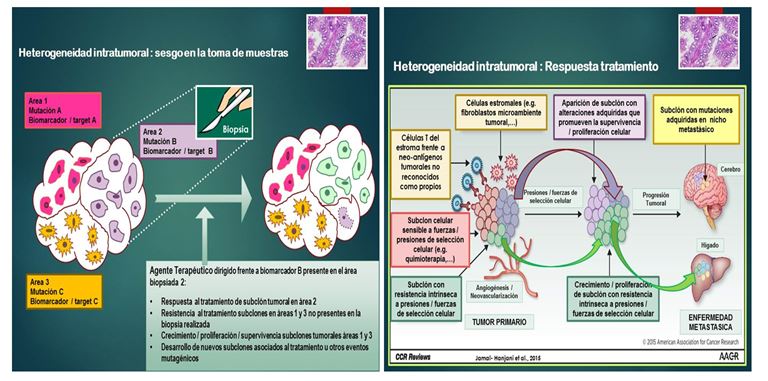
Follicular cell derived thyroid tumors constitute an attractive model where to study inter- and intra-tumor heterogeneity
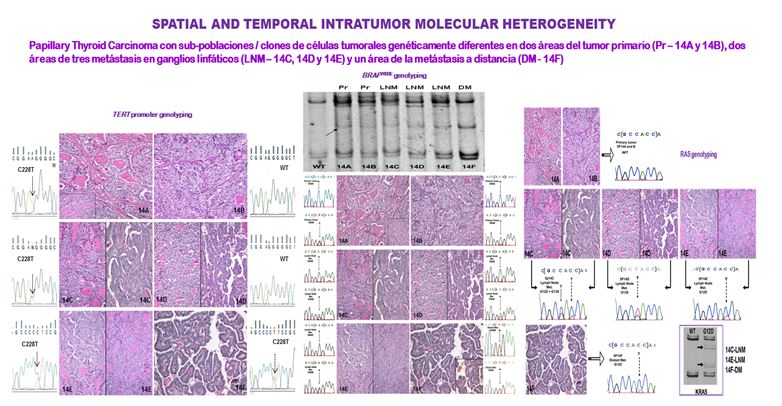
Sporadic thyroid follicular cell tumorigenesis encompasses several histopathological tumor types, originating from the same cell (epithelial follicular cell), with different degrees of differentiation and aggressiveness. Furthermore, nowadays there is compelling histopathogenetic evidence supporting a stepwise PROGRESSION from indolent, “bona fide”, differentiated thyroid carcinomas of papillary (PTC) or follicular (FTC) type to highly aggressive poorly differentiated (PDC) and undifferentiated (UC) thyroid carcinomas
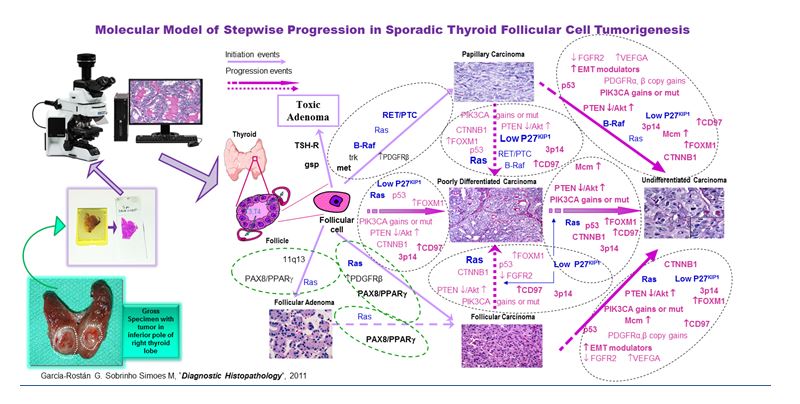
Thyroid cancer is the most prevalent type of endocrine malignancy. Its incidence is rising much faster than the incidence of many other human cancers. It discloses the highest annual percentage increase in incidence among all cancer sites.
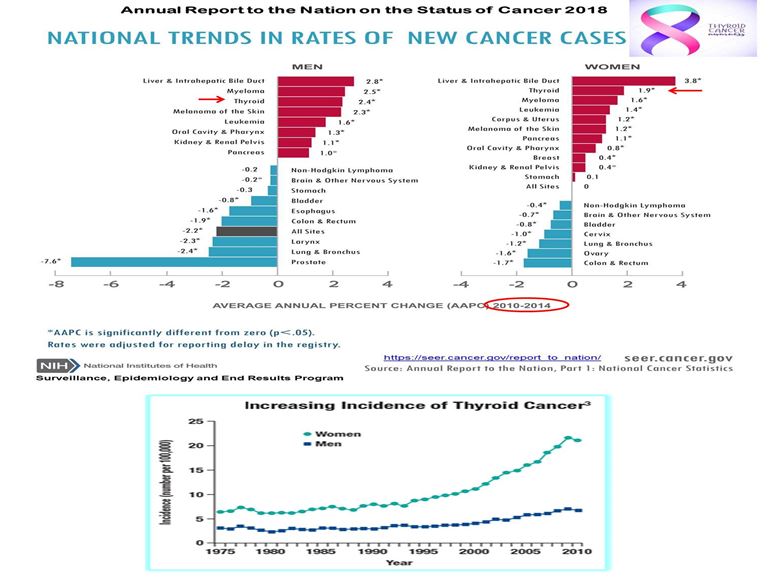
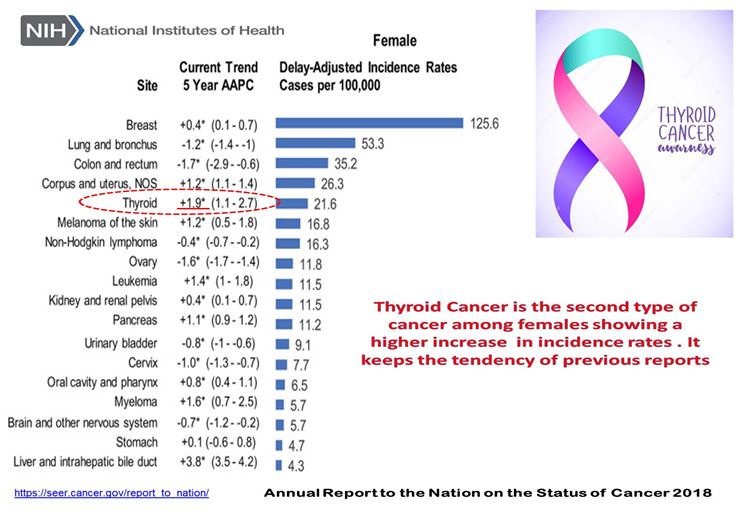

Escalation in thyroid cancer incidence that is paralleled by a gradual increase of thyroid tumors considered “Orhpan Cancers”, a group of aggressive thyroid carcinomas for which there is not an effective treatment and therapy remains a challenge pending to solve: 1) advanced, metastatic radioiodine resistant papillary thyroid carcinomas associated with high morbidity and mortality rates, 2) poorly differentiated thyroid carcinomas associated with 5, 10 and 15 years survival rates of 50%, 34% and 0% respectively, 3) undifferentiated / anaplastic thyroid carcinomas associated with a dismal prognosis, dying of disease few months after diagnosis.

Main research Topics:
Current projects are focused in:
- The study dynamic changes in mutational load distribution (clonal diversity) that occur through space and time. We want to understand why cancer cell subpopulations vary over time and how does it influence and is influenced by clinical events such as therapy and disease progression. The analysis of genetic dynamics of cancer cell clones can provide a fresh outlook on the most challenging problem of all in modern thyroid cancer research, the development of new therapeutic strategies based on the molecular understanding of cancer. Moreover, the study of dynamic changes in mutational load distribution (clonal diversity) that occur through space and time provides a unique opportunity to translate basic research into clinically relevant knowledge with impact on clinical management of cancer progression, drug resistance and ultimately patient survival
- The identification of new molecular mechanisms governing, at the cellular level, the transformation of indolent, morphological indistinguishable differentiated Papillary Thyroid Carcinomas or minimally invasive differentiated Follicular Thyroid Carcinomas into highly aggressive Poorly Differentiated Thyroid Carcinomas or Undifferentiated / Anaplastic Thyroid Carcinomas
- The identification and characterization of new signalling pathways and molecules involved in thyroid follicular cell neoplastic transformation, which exert a pivotal role in tumor maintenance, tumor progression (appearance of recurrences, cell migration, acquisition of metastatic properties, epithelial- mesenchymal transition, stemness perpetuation) and intrinsic or acquired resistance to conventional therapies or targeted drugs. We aim to set up:
- A collection/ series of genes, transcriptional / post-transcriptional regulators, and proteins that command clinical course in orphan thyroid cancers. Prognostic biomarkers which can be easily dosed by means of non-invasive techniques in clinical practice and may help clinicians in the molecular classification of thyroid cancer patients, improving the current tools for diagnosis, staging /stratification, surveillance and management.
- Diagnostic, prognostic and therapeutic algorithms in keeping with the genome / transcriptome signature of each thyroid cancer patient. Molecular based predictive models, which may help clinicians to apply rationally designed targeted therapies tailored to the molecular profile of the patient
- The identification of interactions / cross-talks between activated effectors of the RAS/BRAF/ERK pathway, the PI3K/AKT pathway, the Wnt pathway or the activated TERT promoter and other unknown molecules, which may exert a key role in the partial, self-limited response observed so far to kinase inhibitors and other targeted drugs given to patients with advanced, metastatic, radioiodine resistant papillary thyroid carcinomas, poorly differentiated thyroid carcinomas and undifferentiated / anaplastic thyroid carcinomas
Most relevant publications:
Selected publication
- AUTHORS (in order of authorship): Meana,G. García-Rostán, L. Peña, G. Lordén, A. Cubero, A. Orduña, B. Győrffy, J. Balsinde, MA Balboa.“The phosphatidic acid phosphatase lipin-1 facilitates inflammation-driven colon carcinogenesis”.Journal of Clinical Investigation Insight, September 2018 Epub ahead of print, 2018, 3(18).https://insight.jci.org/articles/view/97506
- AUTHORS (in order of authorship): Casado-Medrano, L. Barrio-Real,G. García-Rostán, M. Baumann, O. Rocks, MJ. Caloca.“A NEW ROLE OF THE RAC-GAP Β2-CHIMAERIN IN CELL ADHESION REVEALS OPPOSITE FUNCTIONS IN BREAST CANCER INITIATION AND TUMOR PROGRESSION”. Oncotarget, April, 2016, 7(19): 28301-19.http://www.impactjournals.com/oncotarget/index.php?journal=oncotarget&page=article&op=view&path[]=8597&pubmed-linkout=1.IMPACT FACTOR AT THE YEAR OF PUBLICATION:5.17.JOURNAL RANKING AT THE YEAR OF PUBLICATION: Position 44 of 217 journals in Oncology category (D2, T1, Q1); Position 48 of 190 journals in ” Cell Biology” (D3, T1, Q2) .TOTAL NUMBER OF TIMES CITED: 5 (ISI-WOS), 6 (Scopus), 9 (Google Scholar)
- AUTHORS (in order of authorship): Ward, R. Lake, PL. Martin, K. Killian, P. Salerno, T. Wang, P. Meltzer, M. Merino, S-y Cheng, M.Santoro, G. Garcia-Rostan, and K. Kelly.“CD97 amplifies LPA receptor signaling and promotes thyroid cancer progression in a mouse model”.Oncogene, May 30th, 2013, 32(22): 2726-38.http://www.ncbi.nlm.nih.gov/pubmed/22797060.IMPACT FACTOR AT THE YEAR OF PUBLICATION:8.56 .JOURNAL RANKING AT THE YEAR OF PUBLICATION: Position 12 of 202 journals in Oncology category (D1, T1, Q1), position 13 of 164 journals in Genetics & Heredity category (D1, T1, Q1), position 26 of 185 journals in Cell Biology category (D2, T1, Q1), and position 24 of 291 journals in Biochemistry & Molecular biology category (D1, T1, Q1).TOTAL NUMBER OF TIMES CITED: 25 (ISI-WOS), 28 (Scopus), 40 (Google Scholar)
- AUTHORS (in order of authorship): Bellelli, MD. Castellone, G. Garcia-Rostan, C. Ugolini, C. Nucera, PM. Sadow, TC. Nappi, P. Salerno, M Cantisani, F. Basolo, T. Alvarez Gago, G. Salvatore, M. Santoro.“FOXM1 IS A MOLECULAR DETERMINANT OF THE MITOGENIC AND INVASIVE PHENOTYPE OF ANAPLASTIC THYROID CARCINOMA”. Endocrine Related Cancer, September 21st, 2012, 19(5): 695-710.http://www.ncbi.nlm.nih.gov/pubmed/22919068.IMPACT FACTOR AT THE YEAR OF PUBLICATION:5.26.JOURNAL RANKING AT THE YEAR OF PUBLICATION: Position 18 of 122 journals in Endocrinology & Metabolism category (D2, T1, Q1), position 31 of 197 journals in Oncology category (D2, T1, Q1).TOTAL NUMBER OF TIMES CITED: 21 (ISI-WOS), 21 (Scopus), 35 (Google Scholar)
- AUTHORS (in order of authorship): Salerno, G. Garcia-Rostan, S. Piccinin, TC. Bencivenga, G. Di Maro, C. Doglioni, F. Basolo, R. Maestro, A. Fusco, M. Santoro, G. Salvatore..“TWIST1 plays a pleiotropic role in determining the anaplastic thyroid cancer phenotype”. The Journal of Clinical Endocrinology and Metabolism, May 2011, 96(5): E772-81. http://www.ncbi.nlm.nih.gov/pubmed/21389145.IMPACT FACTOR AT THE YEAR OF PUBLICATION:5.97.JOURNAL RANKING AT THE YEAR OF PUBLICATION: Position 15 of 122 journals in Endocrinology & Metabolism category (D2, T1, Q1).TOTAL NUMBER OF TIMES CITED: 22 (ISI-WOS), 26 (Scopus), 35 (Google Scholar)
- AUTHORS (in order of authorship): Costa, A. Herrero, MF. Fresno, J. Heymann, JA. Alvarez, J. Cameselle-Teijeiro, G. García-Rostán..“BRAF mutation associated with other genetic events identifies a subset of aggressive Papillary thyroid carcinoma”.Clinical Endocrinology (Oxf), April 2008, 68(4): 618-34. http://www.ncbi.nlm.nih.gov/pubmed/18070147?ordinalpos=1&itool=EntrezSystem2.PEntrez.Pubmed.Pubmed_ResultsPanel.Pubmed_RVDocSum.IMPACT FACTOR AT THE YEAR OF PUBLICATION:3.4 .JOURNAL RANKING AT THE YEAR OF PUBLICATION: Position 34 of 93 journals in Endocrinology & Metabolism category (D4, T2, Q2).TOTAL NUMBER OF TIMES CITED: 87 (ISI-WOS), 79(Scopus), 124 (Google Scholar)
- AUTHORS (in order of authorship): Lima, T. Feijao, A. Ferreira da Silva, I. Pereira-Castro, G. Fernandez-Ballester, V. Maximo, A. Herrero, L. Serrano, M. Sobrinho-Simoes, G. Garcia-Rostan.“HIGH FREQUENCY OF GERMLINE SUCCINATE DEHYDROGENASE MUTATIONS IN SPORADIC CERVICAL PARAGANGLIOMAS IN NORTHERN SPAIN: Mitochondrial Succinate Dehydrogenase Structure-Function relationships and clinical-pathological correlations”. The Journal of Clinical Endocrinology and Metabolism, December 2007, 92(12): 4853-64.http://www.ncbi.nlm.nih.gov/pubmed/17848412?ordinalpos=2&itool=EntrezSystem2.PEntrez.Pubmed.Pubmed_ResultsPanel.Pubmed_RVDocSum.IMPACT FACTOR AT THE YEAR OF PUBLICATION: 5.49 .JOURNAL RANKING AT THE YEAR OF PUBLICATION:Position 11 of 92 journals in Endocrinology & Metabolism category (D2,T1,Q1).TOTAL NUMBER OF TIMES CITED: 35 (ISI-WOS), 35 (Scopus), 48 (Google Scholar)
- AUTHORS (in order of authorship): García–Rostán, AM Costa, I Pereira-Castro, G. Salvatore; R. Hernandez, MJA Hermsem, A. Herrero, A. Fusco, J. Cameselle-Teijeiro, M. Santoro.“MUTATION OF THE PIK3CA GENE IN ANAPLASTIC THYROID CANCER”. Cancer Research, November 15th, 2005, 65(22): 10199-207.http://www.ncbi.nlm.nih.gov/entrez/query.fcgi?cmd=Retrieve&db=pubmed&dopt=Abstract&list_uids=16288007&query_hl=7&itool=pubmed_docsum.IMPACT FACTOR AT THE YEAR OF PUBLICATION:7.61 .JOURNAL RANKING AT THE YEAR OF PUBLICATION: Position 11 of 123 journals in Oncology category (D1, T1, Q1).TOTAL NUMBER OF TIMES CITED: 217 (ISI-WOS), 229 (Scopus), 329 (Google Scholar).This paper has been highlighted in volume 13 of Nature Review Cancer March 2013 “Molecular Pathogenesis and mechanisms of thyroid cancer” with the following comment: “This is the first study that demonstrates common PIK3CA mutations in ATC”. It has also been cited in several reference books of Pathology, Genetics and Molecular Pathology of Thyroid Tumors.
- AUTHORS (in order of authorship): Guida, G. Salvatore, P. Faviana, R. Giannini, G. Garcia-Rostan, L. Provitera, F. Basolo, A. Fusco, F. Carlomagno, M. Santoro.“MITOGENIG EFFECTS OF THE UP-REGULATION OF MINICHROMOSOME MAINTENANCE (MCM) PROTEINS IN ANAPLASTIC THYROID CARCINOMA”. The Journal of Clinical Endocrinology and Metabolism, August 2005, 90(8): 4703-09.http://www.ncbi.nlm.nih.gov/entrez/query.fcgi?cmd=Retrieve&db=pubmed&dopt=Abstract&list_uids=15899946&query_hl=7&itool=pubmed_docsum.IMPACT FACTOR AT THE YEAR OF PUBLICATION: 6.02 .JOURNAL RANKING AT THE YEAR OF PUBLICATION:Position 8 of 89 journals in Endocrinology & Metabolism category(D1, T1, Q1).TOTAL NUMBER OF TIMES CITED: 33 (ISI-WOS), 37 (Scopus), 71(Google Scholar)
- AUTHORS (in order of authorship): García-Rostán, H. Zhao, RL. Camp, M. Pollan, A. Herrero, J. Pardo, R. Wu, ML. Carcangiu, J. Costa, G. Tallini.“RAS MUTATIONS ARE ASSOCIATED WITH AGGRESSIVE TUMOR PHENOTYPES AND POOR PROGNOSIS IN THYROID CANCER”. Journal of Clinical Oncology, September 1, 2003, 21(17): 3226-35.http://www.ncbi.nlm.nih.gov/entrez/query.fcgi?cmd=Retrieve&db=pubmed&dopt=Abstract&list_uids=12947056&query_hl=7&itool=pubmed_docsum.IMPACT FACTOR AT THE YEAR OF PUBLICATION:10.86 .JOURNAL RANKING AT THE YEAR OF PUBLICATION: Position 5 of 120 journals in Oncology category (D1, T1, Q1).strong>TOTAL NUMBER OF TIMES CITED: 242 (ISI-WOS), 259 (Scopus), 274 (Google Scholar).This paper has been highlighted in volume 6 of Nature Review Cancer April 2006 “Pathogenetic mechanisms in thyroid follicular-cell neoplasia” with the following comment: “A thorough and meticulous report that demonstrates the relative infrequency of Ras mutations in activating MAPK signaling in well-differentiated thyroid carcinomas, along with the higher incidence of these mutations in poorly differentiated carcinomas”. It has also been cited in several reference books of Pathology, Genetics and Molecular Pathology of Thyroid Tumors.
- AUTHORS (in order of authorship): Moreno-Bueno, D. Hardisson, C. Sanchez, D. Sarrio, R. Cassia, G. García-Rostán, J. Prat, M.Guo, JG. Herman, X. Matias-Guiu, M. Esteller, J. Palacios.“ABNORMALITIES OF THE APC/Beta-catenin PATHWAY IN ENDOMETRIAL CANCER”. Oncogene, November 2002, 21(52): 7981-90.http://www.ncbi.nlm.nih.gov/entrez/query.fcgi?cmd=Retrieve&db=pubmed&dopt=Abstract&list_uids=12439748&query_hl=7&itool=pubmed_docsum.IMPACT FACTOR AT THE YEAR OF PUBLICATION: 5.97 .JOURNAL RANKING AT THE YEAR OF PUBLICATION: Position 10 of 114 journals in Oncology category (D1, T1, Q1), position 16 of 115 journals in Genetics & Heredity category(D2, T1, Q1), position 26 of 153 journals in Cell Biology category (D2, T1, Q1), and position 32 of 266 journals in Biochemistry & Molecular biology category (D2, T1, Q1).TOTAL NUMBER OF TIMES CITED: 167 (ISI-WOS), 176 (Scopus), 238 (Google Scholar)
- AUTHORS (in order of authorship): Fusco, G. Chiappetta, P. Hui, G. García-Rostán, L. Golden, BK. Zinder, DA. Dillon, A. Giuliano, A. Ciracifi, M. Santoro, J. Rosai, G. Tallini.“ASSESSMENT OF RET/PTC ONCOGENE ACTIVATION AND CLONALITY IN THYROID NODULES WITH INCOMPLETE MORPHOLOGICAL EVIDENCE OF PAPILLARY CARCINOMA: A SEARCH FOR THE EARLY PRECURSORS OF PAPILLARY CANCER”. The American Journal of Pathology. Cellular and Molecular Biology of Disease. June 2002, 160(6): 2157-67.http://www.ncbi.nlm.nih.gov/entrez/query.fcgi?cmd=Retrieve&db=pubmed&dopt=Abstract&list_uids=12057919&query_hl=7&itool=pubmed_docsum.IMPACT FACTOR AT THE YEAR OF PUBLICATION: 6.75 .JOURNAL RANKING AT THE YEAR OF PUBLICATION: Position 1 of 64 journals in Pathology category (D1, T1, Q1).First journal in its knowledge area.TOTAL NUMBER OF TIMES CITED: 92 (ISI-WOS), 109 (Scopus), 156 (Google Scholar)
- AUTHORS (in order of authorship): Santoro, M. Papotti, G. Chiappetta, G. García-Rostán, M. Volante, Ch. Johnson, RL. Camp, F. Pentimalli, C. Monaco, A. Herrero, ML. Carcangiu, A. Fusco, G. Tallini.“RET ACTIVATION AND CLINICOPATHOLOGIC FEATURES IN POORLY DIFFERENTIATED THYROID TUMORS”. The Journal of Clinical Endocrinology and Metabolism, January 2002, 87(1): 370-79.http://www.ncbi.nlm.nih.gov/entrez/query.fcgi?cmd=Retrieve&db=pubmed&dopt=Abstract&list_uids=11788678&query_hl=7&itool=pubmed_docsum.IMPACT FACTOR AT THE YEAR OF PUBLICATION:5.2 .JOURNAL RANKING AT THE YEAR OF PUBLICATION:Position 13 of 88 journals in Endocrinology & Metabolism category (D2, T1, Q1).TOTAL NUMBER OF TIMES CITED: 76 (ISI-WOS), 83 (Scopus), 118 (Google Scholar)
- AUTHORS (in order of authorship): García-Rostán, RL. Camp, A. Herrero, ML. Carcangiu, DL. Rimm, G. Tallini.“Beta-CATENIN DYSREGULATION IN THYROID NEOPLASMS : DOWNREGULATION, ABERRANT NUCLEAR EXPRESSION AND CTNNB1 EXON 3 MUTATIONS ARE MARKERS FOR AGGRESSIVE TUMOR PHENOTYPES AND POOR PROGNOSIS”.The American Journal of Pathology. Cellular and Molecular Biology of Disease. March 2001, 158 (3): 987-996.http://www.ncbi.nlm.nih.gov/entrez/query.fcgi?cmd=Retrieve&db=pubmed&dopt=Abstract&list_uids=11238046&query_hl=7&itool=pubmed_docsum.IMPACT FACTOR AT THE YEAR OF PUBLICATION: 7.1 .JOURNAL RANKING AT THE YEAR OF PUBLICATION: Position 2 of 66 journals in Pathology category (D1, T1, Q1). Second journal in its knowledge area.TOTAL NUMBER OF TIMES CITED: 190 (ISI-WOS), 204 (Scopus), 298 (Google Scholar). This paper has been highlighted in volume 6 of Nature Review Cancer April 2006 “Pathogenetic mechanisms in thyroid follicular-cell neoplasia” with the following comment: “The first identified molecular alteration in poorly differentiated thyroid carcinomas, explaining the phenotype and the behavior”. It has also been cited in several reference books of Pathology, Genetics and Molecular Pathology of Thyroid Tumors
- AUTHORS (in order of authorship): Tallini, G. García-Rostán, A. Herrero, D. Zelterman, G. Viale, S. Bosari, ML. Carcangiu. “DOWNREGULATION OF p27 AND Ki67/ Mib 1 LABELING INDEX SUPPORT THE CLASSIFICATION OF THYROID CARCINOMA INTO PROGNOSTICALLY RELEVANT CATEGORIES”. The American Journal of Surgical Pathology. June 1999, 23(6): 678-685.http://www.ncbi.nlm.nih.gov/entrez/query.fcgi?cmd=Retrieve&db=pubmed&dopt=Abstract&list_uids=10366150&query_hl=7&itool=pubmed_docsum.IMPACT FACTOR AT THE YEAR OF PUBLICATION:3.91 .JOURNAL RANKING AT THE YEAR OF PUBLICATION: Position 5 of 66 journals in Pathology category (D1, T1, Q1), position 3 of 131 journals in Surgery category (D1, T1, Q1). TOTAL NUMBER OF TIMES CITED: 99 (ISI-WOS), 107 (Scopus), 136 (Google Scholar)
- AUTHORS (in order of authorship): Tallini, A. Hsueh, S. Liu, G. García-Rostán, MR. Speicher, DC. Ward.“FREQUENT CHROMOSOMAL DNA UNBALANCE IN THYROID ONCOCYTIC (HüRTHLE CELL) NEOPLASMS DETECTED BY COMPARATIVE GENOMIC HYBRIDIZATION”. Laboratory Investigation, May, 1999, 79(5): 547-555.http://www.ncbi.nlm.nih.gov/entrez/query.fcgi?cmd=Retrieve&db=pubmed&dopt=Abstract&list_uids=10334566&query_hl=7&itool=pubmed_docsum.IMPACT FACTOR AT THE YEAR OF PUBLICATION:4.53 .JOURNAL RANKING AT THE YEAR OF PUBLICATION: Position 3 of 66 journals in Pathology category (D1, T1, Q1) and position 6 of 76 journals in Medicine & Research Experimental category (D1, T1, Q1).TOTAL NUMBER OF TIMES CITED: 59 (ISI-WOS), 63 (Scopus), 80 (Google Scholar)
- AUTHORS (in order of authorship): García-Rostán, G. Tallini, A. Herrero, TG. D’Aquila, ML. Carcangiu, DL. Rimm.“FREQUENT MUTATION AND NUCLEAR LOCALIZATION OF Beta-CATENIN IN ANAPLASTIC THYROID CARCINOMA”. Cancer Research, April 15th 1999, 59(8): 1811-1815.http://www.ncbi.nlm.nih.gov/entrez/query.fcgi?cmd=Retrieve&db=pubmed&dopt=Abstract&list_uids=10213482&query_hl=7&itool=pubmed_docsum.IMPACT FACTOR AT THE YEAR OF PUBLICATION:8.61 .JOURNAL RANKING AT THE YEAR OF PUBLICATION: Position 4 of 105 journals in Oncology category (D1, T1, Q1).TOTAL NUMBER OF TIMES CITED: 251 (ISI-WOS), 270 (Scopus), 380 (Google Scholar).This paper has been highlighted in volume 13 of Nature Reviews Cancer March 2013 “Molecular pathogenesis and mechanisms of thyroid cancer” with the following comment “This is the first study to demonstrate common mutations in β-catenin in ATC”. It has also been cited in several reference books of Pathology, Genetics and Molecular Pathology of Thyroid Tumors

MAIN GROUP STRENGHTS:
Our research is based on “our own” archive of A) well characterized fresh frozen and formalin fixed paraffin embedded patient material [pairs tumoral – non tumoral tissue; pairs primary tumor – recurrences - lymph node metastases – distant metastases] covering the whole spectrum of differentiation and clinical behaviour in thyroid follicular cell tumorigenesis; B) blood samples for the discovery of cell-free nucleic acids and circulating tumor cells; C) a representative healthy control population for the identification and characterization of polymorphisms, D) well-characterized primary short-term, patient derived, cell cultures and human thyroid cancer cell lines.
We deal with one of the biggest worldwide cohort of poorly differentiated and undifferentiated / anaplastic thyroid carcinomas. Tumors that have been collected in the course of 15 years and diagnosed or reviewed by expert thyroid pathologists. In all the cases we have detailed clinical-pathological data and follow- up information for the correlation with molecular data.
We also handle precious tumor material from thyroid cancer patients that have been treated with kinase inhibitors. One issue that results extremely helpful in molecular studies dealing with tumor response / resistance to targeted drugs
Impact of Research. The group officially started at IBGM in January 2015. Shortly will be published the first papers together. We seek to keep the good level of publication of the group leader before returning to Spain. Dr García Rostán has published a number of seminal papers on the biological and clinico-pathological importance of genetic alterations in the evaluation and treatment of different types of thyroid carcinomas. Many of those papers are very well known and still belong to the category of “highly cites papers” of the ISI-web of Knowledge and Scopus database, being considered as major breakthroughs of translational research on thyroid cancer. Nearly 42% of the papers published by Dr. García Rostán rank in the first decile of Journal Citation Reports.
Our collaborations. We have several collaborations with international, landmark groups in the field of cellular and molecular biology of thyroid cancer. The thesis of one of the pre-doctoral students is co-directed by Massimo Santoro, a worldwide leading scientist in the field of thyroid cancer research. We also have well established collaborations with pathologists, endocrinologists and oncologists working at different hospitals throughout Spain.
Our students. The group supervises graduate and summer students. In year 2016 we had two students in the laboratory. A third year medical student (Paloma Pérez Lopez) funded by a summer fellowship of the Spanish Association for Cancer Research (AECC) and a master student (Miriam Corraliza Gomez), whose master project got the maximun score among all the projects presented on her class – year [first class grade with honors / Sobresaliente “cum laude” – Matricula de Honor – Premio Extraordinario 2016]. In 2018 we have had two master students (Sara Gil Bernabé and María Angeles Rodríguez García), whose master projeccts were scored above 8. We are very proud of all of them. The group also participates in formative activities included in the Master and the PhD program. Likewise, supervises the molecular pathology training program of undergradute medical students who have obtained by public competition a 3 year internship in the Pathology Deparment. We are always looking for bright and highly motivated people who wish to pursue an internationally competitive scientific career
Key expertise in translational research. The dual competence in pathology and molecular biology of the group leader is not frequent and allows the group to develop original approaches and outlooks in thyroid translational research. The double expertise at both morphological and molecular level results pivotal in the selection of cases to analyze as well as in the study design, avoiding frequent confounding factors or bias present in studies without such expertise in the group. The clinical and the pathology expertise are also relevant for establishing molecular correlates with clinico-pathological data and follow-up information
The group leader has a wide experience in the analysis of inter- and intra-tumor heterogeneity. Most of the mutational / expression studies she has performed in the past have considered that aspect. Different areas within the primary tumor with different grade of differentiation, different microscopic appearance or pattern of growth, recurrences, lymph node and/or distant metastasis at diagnosis and during follow- up have been separately characterized.
Currently, we are approaching a detailed genetic mapping of cancer cell subpopulations over space and time, in advanced, metastatic, radioiodine resitant papillary thyroid carcinomas. We are analyzing the genetic dynamics, plasticity of cancer cells clones with origin in the same cell type, which occupy separate patches of a subdivided habitat and fluctuate over time. The pathology expertise results essential in detecting dynamic changes in mutational load distribution (clonal diversity) that occur through space and time.
